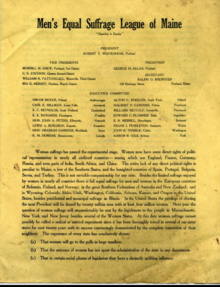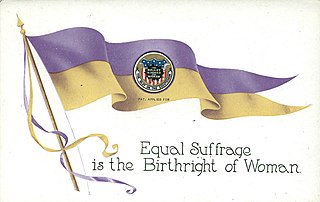
The National American Woman Suffrage Association (NAWSA) was an organization formed on February 18, 1890, to advocate in favor of women's suffrage in the United States. It was created by the merger of two existing organizations, the National Woman Suffrage Association (NWSA) and the American Woman Suffrage Association (AWSA). Its membership, which was about seven thousand at the time it was formed, eventually increased to two million, making it the largest voluntary organization in the nation. It played a pivotal role in the passing of the Nineteenth Amendment to the United States Constitution, which in 1920 guaranteed women's right to vote.

Florence Brooks Whitehouse was an American suffragist, activist and novelist from Maine. In 2008, Whitehouse was inducted to the Maine Women's Hall of Fame. She was an early feminist who was considered radical for her support of Alice Paul and the tactics of the National Woman's Party.

Women's suffrage was established in the United States on a full or partial basis by various towns, counties, states, and territories during the latter decades of the 19th century and early part of the 20th century. As women received the right to vote in some places, they began running for public office and gaining positions as school board members, county clerks, state legislators, judges, and, in the case of Jeannette Rankin, as a member of Congress.

This is a timeline of women's suffrage in Ohio. Women's suffrage activism in Ohio began in earnest around the 1850s, when several women's rights conventions took place around the state. The Ohio Women's Convention was very influential on the topic of women's suffrage, and the second Ohio Women's Convention in Akron, Ohio, featured Sojourner Truth and her famous speech, Ain't I a Woman? Women worked to create organizations and groups to influence politicians on women's suffrage. Several state constitutional amendments for women's suffrage did not pass. However, women in Ohio did get the right to vote in school board elections and in some municipalities before Ohio became the fifth state to ratify the Nineteenth Amendment.

This is a timeline of women's suffrage in Montana. The fight for women's suffrage in Montana started earlier, before even Montana became a state. In 1887, women gained the right to vote in school board elections and on tax issues. In the years that followed, women battled for full, equal suffrage, which culminated in a year-long campaign in 1914 when they became one of eleven states with equal voting rights for most women. Montana ratified the Nineteenth Amendment on August 2, 1919 and was the thirteenth state to ratify. Native American women voters did not have equal rights to vote until 1924.

The women's suffrage movement in Montana started while it was still a territory. The Women's Christian Temperance Union (WCTU) was an early organizer that supported suffrage in the state, arriving in 1883. Women were given the right to vote in school board elections and on tax issues in 1887. When the state constitutional convention was held in 1889, Clara McAdow and Perry McAdow invited suffragist Henry Blackwell to speak to the delegates about equal women's suffrage. While that proposition did not pass, women retained their right to vote in school and tax elections as Montana became a state. In 1895, National American Woman Suffrage Association (NAWSA) came to Montana to organize local groups. Montana suffragists held a convention and created the Montana Woman's Suffrage Association (MWSA). Suffragists continued to organize, hold conventions and lobby the Montana Legislature for women's suffrage through the end of the nineteenth century. In the early twentieth century, Jeannette Rankin became a driving force around the women's suffrage movement in Montana. By January 1913, a women's suffrage bill had passed the Montana Legislature and went out as a referendum. Suffragists launched an all-out campaign leading up to the vote. They traveled throughout Montana giving speeches and holding rallies. They sent out thousands of letters and printed thousands of pamphlets and journals to hand out. Suffragists set up booths at the Montana State Fair and they held parades. Finally, after a somewhat contested election on November 3, 1914, the suffragists won the vote. Montana became one of eleven states with equal suffrage for most women. When the Nineteenth Amendment was passed, Montana ratified it on August 2, 1919. It wasn't until 1924 with the passage of the Indian Citizenship Act that Native American women gained the right to vote.

The first women's suffrage group in Georgia, the Georgia Woman Suffrage Association (GWSA), was formed in 1892 by Helen Augusta Howard. Over time, the group, which focused on "taxation without representation" grew and earned the support of both men and women. Howard convinced the National American Women's Suffrage Association (NAWSA) to hold their first convention outside of Washington, D.C., in 1895. The convention, held in Atlanta, was the first large women's rights gathering in the Southern United States. GWSA continued to hold conventions and raise awareness over the next years. Suffragists in Georgia agitated for suffrage amendments, for political parties to support white women's suffrage and for municipal suffrage. In the 1910s, more organizations were formed in Georgia and the number of suffragists grew. In addition, the Georgia Association Opposed to Woman Suffrage also formed an organized anti-suffrage campaign. Suffragists participated in parades, supported bills in the legislature and helped in the war effort during World War I. In 1917 and 1919, women earned the right to vote in primary elections in Waycross, Georgia and in Atlanta respectively. In 1919, after the Nineteenth Amendment went out to the states for ratification, Georgia became the first state to reject the amendment. When the Nineteenth Amendment became the law of the land, women still had to wait to vote because of rules regarding voter registration. White Georgia women would vote statewide in 1922. Native American women and African-American women had to wait longer to vote. Black women were actively excluded from the women's suffrage movement in the state and had their own organizations. Despite their work to vote, Black women faced discrimination at the polls in many different forms. Georgia finally ratified the Nineteenth Amendment on February 20, 1970.
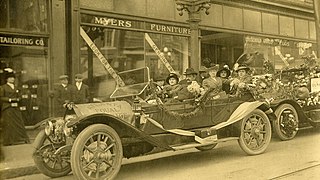
This is a timeline of women's suffrage in Georgia. Women's suffrage in Georgia started in earnest with the formation of the Georgia Woman Suffrage Association (GWSA) in 1892. GWSA helped bring the first large women's rights convention to the South in 1895 when the National American Woman's Suffrage Association (NAWSA) held their convention in Atlanta. GWSA was the main source of activism behind women's suffrage until 1913. In that year, several other groups formed including the Georgia Young People's Suffrage Association (GYPSA) and the Georgia Men's League for Woman Suffrage. In 1914, the Georgia Association Opposed to Women's Suffrage (GAOWS) was formed by anti-suffragists. Despite the hard work by suffragists in Georgia, the state continued to reject most efforts to pass equal suffrage. In 1917, Waycross, Georgia allowed women to vote in primary elections and in 1919 Atlanta granted the same. Georgia was the first state to reject the Nineteenth Amendment. Women in Georgia still had to wait to vote statewide after the Nineteenth Amendment was ratified on August 26, 1920. Native American and African American women had to wait even longer to vote. Georgia ratified the Nineteenth Amendment in 1970.

This is a timeline of women's suffrage in Illinois. Women's suffrage in Illinois began in the mid 1850s. The first women's suffrage group was created in 1855 in Earlville, Illinois by Susan Hoxie Richardson. The Illinois Woman Suffrage Association (IWSA), later renamed the Illinois Equal Suffrage Association (IESA), was created by Mary Livermore in 1869. This group held annual conventions and petitioned various governmental bodies in Illinois for women's suffrage. On June 19, 1891, women gained the right to vote for school offices. However, it wasn't until 1913 that women saw expanded suffrage. That year women in Illinois were granted the right to vote for Presidential electors and various local offices. Suffragists continued to fight for full suffrage in the state. Finally, Illinois became the first state to ratify the Nineteenth Amendment on June 10, 1919. The League of Women Voters (LWV) was announced in Chicago on February 14, 1920.
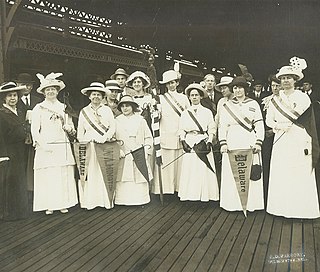
Women's suffrage began in Delaware the late 1860s, with efforts from suffragist, Mary Ann Sorden Stuart, and an 1869 women's rights convention held in Wilmington, Delaware. Stuart, along with prominent national suffragists lobbied the Delaware General Assembly to amend the state constitution in favor of women's suffrage. Several suffrage groups were formed early on, but the Delaware Equal Suffrage Association (DESA) formed in 1896, would become one of the major state suffrage clubs. Suffragists held conventions, continued to lobby the government and grow their movement. In 1913, a chapter of the Congressional Union (CU), which would later be known at the National Woman's Party (NWP), was set up by Mabel Vernon in Delaware. NWP advocated more militant tactics to agitate for women's suffrage. These included picketing and setting watchfires. The Silent Sentinels protested in Washington, D.C., and were arrested for "blocking traffic." Sixteen women from Delaware, including Annie Arniel and Florence Bayard Hilles, were among those who were arrested. During World War I, both African-American and white suffragists in Delaware aided the war effort. During the ratification process for the Nineteenth Amendment, Delaware was in the position to become the final state needed to complete ratification. A huge effort went into persuading the General Assembly to support the amendment. Suffragists and anti-suffragists alike campaigned in Dover, Delaware for their cause. However, Delaware did not ratify the Nineteenth Amendment until March 6, 1923, well after it was already part of the United States Constitution.

Women's suffrage began in Nevada began in the late 1860s. Lecturer and suffragist Laura de Force Gordon started giving women's suffrage speeches in the state starting in 1867. In 1869, Assemblyman Curtis J. Hillyer introduced a women's suffrage resolution in the Nevada Legislature. He also spoke out on women's rights. Hillyer's resolution passed, but like all proposed amendments to the state constitution, must pass one more time and then go out to a voter referendum. In 1870, Nevada held its first women's suffrage convention in Battle Mountain Station. In the late 1880s, women gained the right to run for school offices and the next year several women are elected to office. A few suffrage associations were formed in the mid-1890s, with a state group operating a few women's suffrage conventions. However, after 1899, most suffrage work slowed down or stopped altogether. In 1911, the Nevada Equal Franchise Society (NEFS) was formed. Attorney Felice Cohn wrote a women's suffrage resolution that was accepted and passed the Nevada Legislature. The resolution passed again in 1913 and will go out to the voters on November 3, 1914. Suffragists in the state organized heavily for the 1914 vote. Anne Henrietta Martin brought in suffragists and trade unionists from other states to help campaign. Martin and Mabel Vernon traveled around the state in a rented Ford Model T, covering thousands of miles. Suffragists in Nevada visited mining towns and even went down into mines to talk to voters. On November 3, the voters of Nevada voted overwhelmingly for women's suffrage. Even though Nevada women won the vote, they did not stop campaigning for women's suffrage. Nevada suffragists aided other states' campaigns and worked towards securing a federal suffrage amendment. On February 7, 1920, Nevada became the 28th state to ratify the Nineteenth Amendment.

The first women's suffrage effort in Florida was led by Ella C. Chamberlain in the early 1890s. Chamberlain began writing a women's suffrage news column, started a mixed-gender women's suffrage group and organized conventions in Florida.
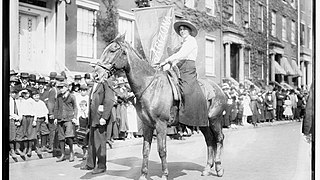
The movement for women's suffrage in Arizona began in the late 1800s. After women's suffrage was narrowly voted down at the 1891 Arizona Constitutional Convention, prominent suffragettes such as Josephine Brawley Hughes and Laura M. Johns formed the Arizona Suffrage Association and began touring the state campaigning for women's right to vote. Momentum built throughout the decade, and after a strenuous campaign in 1903, a woman's suffrage bill passed both houses of the legislature but was ultimately vetoed by Governor Alexander Oswald Brodie.

This is a timeline of women's suffrage in Arizona. The first women's suffrage bill was brought forward in the Arizona Territorial legislature in 1883, but it did not pass. Suffragists worked to influence the Territorial Constitutional Convention in 1891 but lost by only three votes. That year, the Arizona Suffrage Association was formed. In 1897, taxpaying women gained the right to vote in school board elections. Suffragists from both Arizona and around the country continued to lobby the territorial legislature and organize women's suffrage groups. In 1903, a women's suffrage bill passed, but it was vetoed by the governor. In 1910, suffragists worked to influence the Arizona State Constitutional Convention, but were again unsuccessful. When Arizona became a state on February 14, 1912, an attempt to legislate a women's suffrage amendment to the Arizona Constitution failed. Frances Munds mounted a successful ballot initiative campaign. On November 5, 1912, women's suffrage passed in Arizona. In 1913, the voter registration books were opened to women. In 1914, women participated in their first primary elections. Arizona ratified the Nineteenth Amendment on February 12, 1920. However, Native American women and Latinas would wait longer for full voting rights.

While women's suffrage had an early start in Maine, dating back to the 1850s, it was a long, slow road to equal suffrage. Early suffragists brought speakers Susan B. Anthony and Lucy Stone to the state in the mid-1850s. Ann F. Jarvis Greely and other women in Ellsworth, Maine, created a women's rights lecture series in 1857. The first women's suffrage petition to the Maine Legislature was also sent that year. Working-class women began marching for women's suffrage in the 1860s. The Snow sisters created the first Maine women's suffrage organization, the Equal Rights Association of Rockland, in 1868. In the 1870s, a state suffrage organization, the Maine Women's Suffrage Association (MWSA), was formed. Many petitions for women's suffrage were sent to the state legislature. MWSA and the Woman's Christian Temperance Union (WCTU) of Maine worked closely together on suffrage issues. By the late 1880s the state legislature was considering several women's suffrage bills. While women's suffrage did not pass, during the 1890s many women's rights laws were secured. During the 1900s, suffragists in Maine continued to campaign and lecture on women's suffrage. Several suffrage organizations including a Maine chapter of the College Equal Suffrage League and the Men's Equal Rights League were formed in the 1910s. Florence Brooks Whitehouse started the Maine chapter of the National Woman's Party (NWP) in 1915. Suffragists and other clubwomen worked together on a large campaign for a 1917 voter referendum on women's suffrage. Despite the efforts of women around the state, women's suffrage failed. Going into the next few years, a women's suffrage referendum on voting in presidential elections was placed on the September 13, 1920 ballot. But before that vote, Maine ratified the Nineteenth Amendment on November 5, 1920. It was the nineteenth state to ratify. A few weeks after ratification, MWSA dissolved and formed the League of Women Voters (LWV) of Maine. White women first voted in Maine on September 13, 1920. Native Americans in Maine had to wait longer to vote. In 1924, they became citizens of the United States. However, Maine would not allow individuals living on Indian reservations to vote. It was not until the passage of a 1954 equal rights referendum that Native Americans gained the right to vote in Maine. In 1955 Lucy Nicolar Poolaw (Penobscot) was the first Native American living on a reservation in Maine to cast a vote.

Attempts to secure women's suffrage in Wisconsin began before the Civil War. In 1846, the first state constitutional convention delegates for Wisconsin discussed women's suffrage and the final document eventually included a number of progressive measures. This constitution was rejected and a more conservative document was eventually adopted. Wisconsin newspapers supported women's suffrage and Mathilde Franziska Anneke published the German language women's rights newspaper, Die Deutsche Frauen-Zeitung, in Milwaukee in 1852. Before the war, many women's rights petitions were circulated and there was tentative work in forming suffrage organizations. After the Civil War, the first women's suffrage conference held in Wisconsin took place in October 1867 in Janesville. That year, a women's suffrage amendment passed in the state legislature and waited to pass the second year. However, in 1868 the bill did not pass again. The Wisconsin Woman Suffrage Association (WWSA) was reformed in 1869 and by the next year, there were several chapters arranged throughout Wisconsin. In 1884, suffragists won a brief victory when the state legislature passed a law to allow women to vote in elections on school-related issues. On the first voting day for women in 1887, the state Attorney General made it more difficult for women to vote and confusion about the law led to court challenges. Eventually, it was decided that without separate ballots, women could not be allowed to vote. Women would not vote again in Wisconsin until 1902 after separate school-related ballots were created. In the 1900s, state suffragists organized and continued to petition the Wisconsin legislature on women's suffrage. By 1911, two women's suffrage groups operated in the state: WWSA and the Political Equality League (PEL). A voter referendum went to the public in 1912. Both WWSA and PEL campaigned hard for women's equal suffrage rights. Despite the work put in by the suffragists, the measure failed to pass. PEL and WWSA merged again in 1913 and women continued their education work and lobbying. By 1915, the National Woman's Party also had chapters in Wisconsin and several prominent suffragists joined their ranks. The National Woman Suffrage Association (NAWSA) was also very present in Wisconsin suffrage efforts. Carrie Chapman Catt worked hard to keep Wisconsin suffragists on the path of supporting a federal woman's suffrage amendment. When the Nineteenth Amendment went out to the states for ratification, Wisconsin an hour behind Illinois on June 10, 1919. However, Wisconsin was the first to turn in the ratification paperwork to the State Department.

This is a timeline of women's suffrage in Wisconsin. Women's suffrage efforts began before the Civil War. The first Wisconsin state constitutional convention in 1846 discussed both women's suffrage and African-American suffrage. In the end, a more conservative constitution was adopted by Wisconsin. In the 1850s, a German language women's rights newspaper was founded in Milwaukee and many suffragists spoke throughout the state. The first state suffrage convention was held in Janesville in 1867. The 1870s, several women's suffrage groups were founded in the state. In 1884, a women's suffrage bill, allowing women to vote for school-related issues is passed. In 1886, voters approve the school-related suffrage bill in a referendum. The first year women vote, 1887, there are challenges to the law that go on until Wisconsin women are allowed to vote again for school issues in 1902 using separate ballots. In the 1900s, women's suffrage conventions continue to take place throughout the state. Women collect petitions and continue to lobby the state legislature. In 1911 Wisconsin legislature passes a bill for women's suffrage that will go out to the voters in 1912. On November 4, 1912 voters disapprove of women's suffrage. Women's suffrage efforts continue, including sponsoring a suffrage school and with the inclusion of a National Woman's Party (NWP) chapter formed in 1915. When the Nineteenth Amendment goes out to the states, Wisconsin ratifies on June 10 and turns in the ratification paperwork first, on June 13, 1919.

In 1893, Colorado became the second state in the United States to grant women's suffrage and the first to do so through a voter referendum. Even while Colorado was a territory, lawmakers and other leaders tried to include women's suffrage in laws and later in the state constitution. The constitution did give women the right to vote in school board elections. The first voter referendum campaign was held in 1877. The Woman Suffrage Association of Colorado worked to encourage people to vote yes. Nationally-known suffragists, such as Susan B. Anthony and Lucy Stone spoke alongside Colorado's own Alida Avery around the state. Despite the efforts to influence voters, the referendum failed. Suffragists continued to grow support for women's right to vote. They exercised their right to vote in school board elections and ran for office. In 1893, another campaign for women's suffrage took place. Both Black and white suffragists worked to influence voters, gave speeches, and turned out on election day in a last-minute push. The effort was successful and women earned equal suffrage. In 1894, Colorado again made history by electing three women to the Colorado house of representatives. After gaining the right to vote, Colorado women continued to fight for suffrage in other states. Some women became members of the Congressional Union (CU) and pushed for a federal suffrage amendment. Colorado women also used their right to vote to pass reforms in the state and to support women candidates.

This is a timeline of women's suffrage in New Jersey. Women and African Americans had the right to vote in New Jersey until the state constitution was changed in 1807, disenfranchising all but white men. Any early suffrage protest was taken by Lucy Stone in 1857 who refused to pay her property taxes because she could not vote. Additional attempts to make women more equal under the law took place in the 1880s and 1890s. There were also several court cases that challenged women's right to vote in the state. Eventually, a voter referendum on a state constitutional suffrage amendment took place in 1915, however the measure was voted down. Activists continued to fight both in the state and to protest in Washington, D.C. as Silent Sentinels. By February 10, 1920, New Jersey ratified the Nineteenth Amendment.




